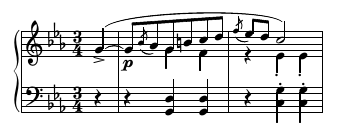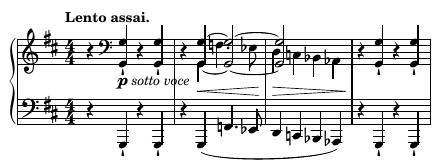Chopin's Mazurkas - Part 4 @ r9
In which I listen to Chopin's Mazurkas and struggle with Lilypond. We begin on Op. 30, No. 1.
Quatre Mazurkas
For à la Princesse de Würtemberg.
Op. 30, No. 1 in C minor
Once again a mazurka starts with a V → i progression.
Truly one of my favorite things in the world.1
The A section ends with a "V of the V" progression and uses
a Picardy third at the end to lead
back nicely to C minor. I talked about the "V of the V" thing and
its prevalence previously in
part 3.
It ends with an interesting
semi-deceptive cadence
by hitting you with a iv before
plagally closing to the i.
Op. 30, No. 2 in B minor
I like the very beginning of this piece. It starts off with a
i → V progression in the first two measures, and then
repeats the same melody but employs an A♮ instead of an A♯ to achieve a
i → v progression.
Since last time I did this I'm always on the lookout for 7♭5 chords, and we've found another in the B section. The B section is mostly a lesson in how the circle of fifths works, but Chopin sneaks in a descending chromatic motif in the left hand to go from C♯7 → F♯m → B7♭5 → E.
I really like these kinds of things because it really emphasizes the importance
of spelling and enharmonics. Tonally it's the same notes with the same frequency,
but in this case the E♯ is very different harmonically from the F♮.
Another reason why I'm not a huge fan of guitar tablature, because you lose
this meaning when you only see, for example, 4 3 on the D string twice
and it's not immediately obvious that the harmony is different since there is no
indication of whether it's an E♯ or an F♮.
In the C section Chopin repeats the idea of the main theme but with different harmonies. The right hand does the same thing four times in a row while the left hand slightly changes the harmony.
This mazurka is unusual in that it ends without gratuitous repeats. It follows an A → B → C → B progression without ever returning to the A section.
Op. 30, No. 3 in D♭ major
Some cool harmonies in this one. I particulary like the reverse (?) Picard Third type thing that occurs at the end of the A section. The piece ends with perhaps a double (?) reverse (?) Picardy third. Meaning, we're in D♭ major, it modulates to D♭ minor, and then hits you with an accented F♮ to re-assert that yes, it is in a major key.
The transition back to the A section at the end of the piece reminds of some Liszt's Sonata in B minor in that there's huge white space interspersed by out-of-key notes, before finally transitioning with full force into something more melodic.
Op. 30, No. 4 in C♯ minor
The intro begins with a little "V of the V" action;
once you notice it one place, it shows up everywhere. Like when you're tired
of losing your car in the parking lot so you buy a new car in a hideous shade
of orange so that it's instantly recognizable and then immediately discover that
everyone already owns an orange car. Or maybe not like that. Whatever.
This mazurka has some very Polonaise-like parts to it. Or at least I was reminded of the Military Polonaise with the stocatto chords. Most of the mazurkas have been understated: not using the whole range of the keyboard, and with honestly not a huge amount of dynamic range. This one breaks from the mould a bit with some fortissimos featuring the low end of the keyboard.
Overall I really liked this one. It's one of my favorites so far in this series.
- I've pontificated on this phenomenon extensively in literally every other part of this series.










